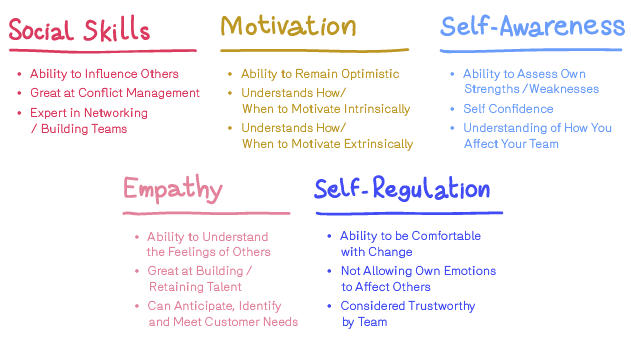— May 9, 2018

As a manager, you act as a mentor, coach, and leader to your team. But that doesn’t mean there should be a level of separation between you and your employees. Quite the opposite—you should be connecting with employees and your team should feel like you’re one of them.
Having a positive relationship with their manager is important to employees. According to Gallup’s 2017 State of the American Workplace Report, “manager or management” is one of the 6 most common reasons that employees cite for voluntarily leaving a job. Connecting with your employees improves their engagement and helps them to succeed, but it can also help you to excel in your role.
By developing your Emotional Intelligence (EQ), you can work on bridging the gap between yourself and your employees. All five domains of EQ (listed below) contribute to your leadership abilities, including how you connect with your employees.

This post will focus on helping you understand Self-Regulation and how it affects your relationships with employees—and give you some tips on improving both.
How Connecting With Your Employees Increases Their Engagement
There are a number of benefits to connecting with employees, and a big one is increasing their engagement. Forming relationships and developing connections with the people they work with, especially their leader, makes them more motivated at work.
Ultimately, forming manager-employee connections is about breaking down barriers and hierarchy. Showing your employees that you’re on their team helps you to build mutual trust and respect with them.
That two-way trust and respect makes it easier for you to facilitate open and honest communication and conflict resolution on your team. It also helps your employees feel empowered to take risks, and less afraid of failure. All of these factors make your employees feel valued, and that will make for a healthier and more engaged team.
So how do you connect with your employees? We have some ideas…
3 Tips on Building Relationships With Your Employees
Starting out on the right foot and forming a connection with your employees from the outset is important. You want to establish yourself as an equal and show a genuine interest in getting to know each of your employees as individuals. These tips can help you start your employee relationships on the right foot.

-
Meet With Your Team
If you’re new to the team, explain your leadership style, your background, and your personal interests to give them a holistic introduction to who you are and how you see yourself fitting in.
-
Meet With Your Employees Individually
Ask about what they’re looking for in a leader and coach, but also about their background and personal interests to get a more well-rounded idea of who they are. If you’re meeting with a new employee, take this as an opportunity to talk about yourself and your leadership style, too.
-
Break The Ice
Do icebreaker games as a quick and fun way for everyone to get to know each other and get a better sense of people’s personalities. You can do this when starting out with a new team or bringing someone new on board.
6 Tips on Maintaining Connections With Your Employees
Once you lay the groundwork for solid relationships to blossom, you also have to work to maintain those connections over time. You want to show your employees that you’re in it for the long haul. These tactics can be implemented in your day-to-day to nurture your employee relationships in the long-term.

-
Build Personal Connections Between Your Employees
Encourage your team to get to know each other personally. The more comfortable everyone is with each other, including you, the more you’ll all have a trusting connection as a team. Schedule team lunches and social events outside of work.
-
Build Professional Connections Between Your Employees
Have different team members work with each other for training and onboarding to develop everyone’s technical skills and increase innovation and collaboration.
-
Keep Things Fun
Occasionally schedule time during the workday to interact as a team outside of the workplace environment. Go out for a group lunch or head to a park for the afternoon. The change in environment will help everyone open up and connect more authentically.
-
Be Transparent
Transparency with decisions, changes, and outcomes is key to maintaining trust and respect between you and your employees. Be as open and honest with your team as you can, with the good and the bad, the big and the small. Encourage your employees to come to you with feedback, questions, and concerns.
-
Check In & Catch Up
During regularly scheduled one-on-one’s, or just in your day-to-day, take 10 minutes to catch up informally with your employees. Ask about their weekend or any good books they’ve read or TV shows they’ve watched lately to check in on a more personal level.
-
Give Recognition
It can’t be stated enough, employees want to receive recognition for their hard work. The best form of recognition is the easiest to give—tell your employee “congratulations on a job well done, I really value your work and dedication.”
Self-Regulation & Manager-Employee Relationships
Part of building trust with your team is forming human connections and being vulnerable, but it’s also about being dependable. You want to show your employees that you’re one of them and be open about your dreams and fears, but you also want them to know that you’re there to support them in theirs. Your employees don’t want you to be a robot, but they do want to know that you’ll be the one to anchor the team when they need you.

Working on your Self-Regulation skills can help you to develop that stability that your team is looking for in your leadership. The first step is becoming Self-Aware, and with that, you can work on your ability to self-regulate.
Self-Regulation is about both your emotions and your behaviour. First, being able to monitor them, and second, being able to control and adjust them according to your circumstances. Regulating your emotions means keeping tabs on how you’re feeling and not letting your emotions take over.
Emotionally, self-regulation is the ability to calm yourself down when you’re upset and cheer yourself up when you’re down.
– Psychology Today
When it comes to behaviour, Self-Regulation is about acting in a way that lines up with your core values instead of your current emotions or impulses. It’s the ability to consider the long-term impact of your behaviour before you act. Behavioural Self-Regulation happens in the space between emotions and actions.
The trust and respect that you form with your employees relies on your Self-Regulation skills as much as your ability to connect with them. Being able to keep calm during times of stress or uncertainty helps your team feel that they can depend on you. Making decisions based on the best long-term outcome for your team instead of acting on impulse helps your employees trust you to guide them.
Develop Your Self-Regulation Skills: Pay attention to the time and space that comes between your emotions and your actions in little ways. Try to take 10 minutes between reading an email and responding to it. Count to five before responding when someone asks you a question. If you feel an intense emotion coming on, take a 15 minute walk and think about the best course of action. The more you take little steps like this, the more Self-Regulation will start to come naturally.
How to Connect With an Employee You Don’t Click With
Sometimes you’ll end up with an employee on your team that you just don’t click with. Your Self-Regulation skills can really come into play in this situation, especially if you start to feel frustrated with the employee or find yourself acting passive-aggressively towards them. Remember that just because you aren’t the best of friends doesn’t mean that you can’t have a positive working relationship.
Here are some tips on how:
- Focus on the work: The goals of the team and the company mission are a built-in common ground, so use that as a way to align yourself with the employee.
- Connect Them With the Right Coach: Depending on the structure of your company, there might be another person who’s better suited to act as a mentor or coach for the employee.
- Be real: Your employees value your authenticity, so don’t pretend to be their best friend if you both know you aren’t a match made in heaven.
- Don’t Gossip: Talking negatively about your employee—especially to other team members—could be really detrimental to the trust you have with your team.
How to Maintain a Professional Relationship With an Employee You’re Friends With
On the other hand, sometimes you’ll hit it off right away with an employee and become work BFFs. This is another situation where your Self-Regulation skills can have a big impact. It’s great to make friends at work, but as your team’s leader you want to avoid your friendships making your other employees feel excluded or envious.
Here are some tips on how:
- Be open about your friendships: Compartmentalizing our lives (“work life,” “personal life,” “family life”) is antiquated anyway. Pretending that you’re not friends with one of your employees could weaken the trust that you have with your other employees.
- Don’t exclude others: Save your one-on-one friend time for outside of working hours. You have lots of time to make inside jokes and have private conversations outside of the office.
- Spread the love: Giving all the fun tasks to an employee you’re friends with is unfair to the rest of the group and will likely lead to hostility and conflict on your team.
Connecting with your employees improves the health and engagement of your team and makes you a stronger leader. Part of building sturdy, trusting relationships with your employees is showing them that they can depend on you, but it doesn’t have to come at the cost of being human and being yourself.
Do you have any tips on connecting with employees?
Share in the comments below!
Business & Finance Articles on Business 2 Community
(92)







